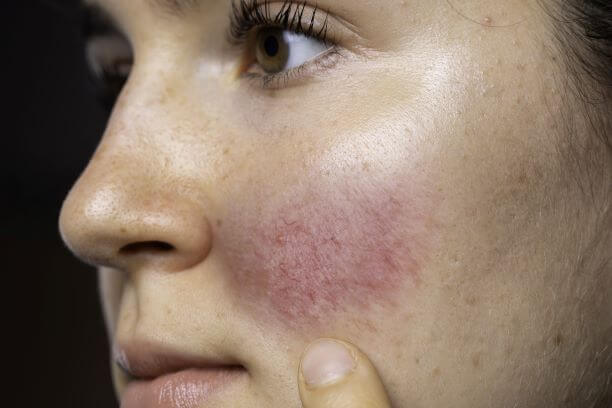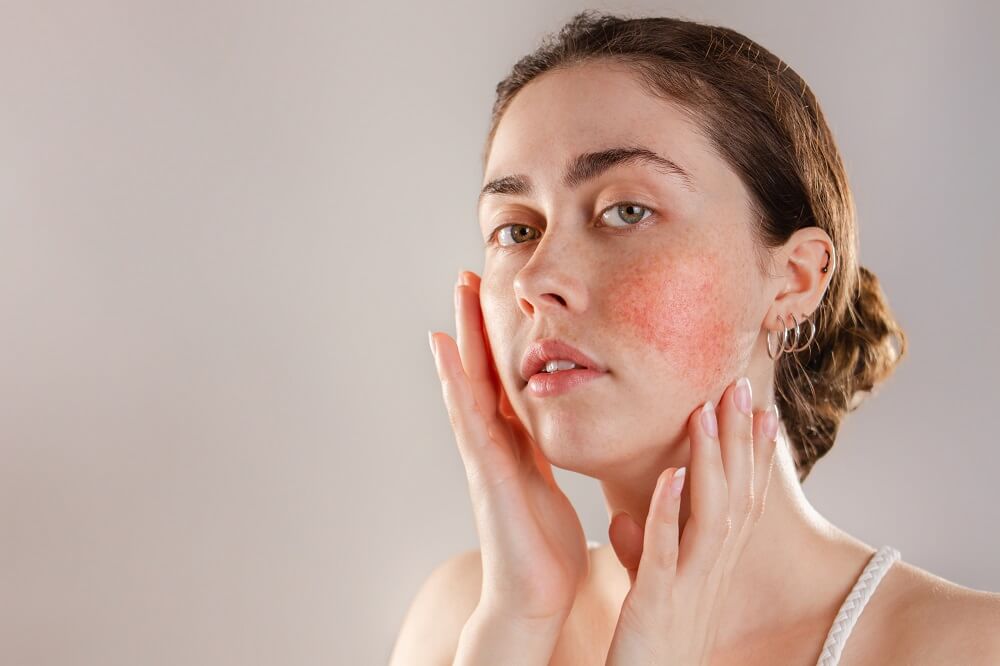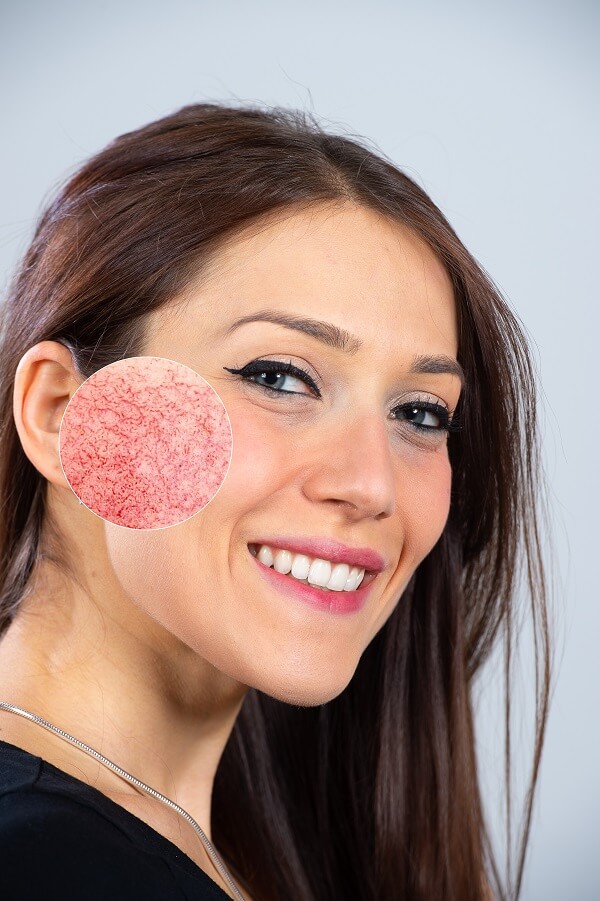Rosacea is a common, chronic, inflammatory skin condition that few people, even those who have been diagnosed with rosacea, know enough about. In this blog we will walk you through some of the basic information about how to identify this condition, including explaining the four different types of rosacea. Many people, even those with rosacea, think that this condition just makes you blush easily or causes redness of the face. Actually, rosacea is a complex skin condition that may involve a wide range of symptoms that get worse when they’re not properly treated. For this reason, people with rosacea should work with a dermatologist to create a daily skincare routine that combats the short term and long term impact of this condition.
What is Rosacea?
Rosacea is a common skin condition that impacts around 15 million people in the U.S. While chronic blushing is what most people associate with rosacea, this is only one symptom of one type of rosacea. In actuality, the inflammatory skin condition includes a much more complex range of symptoms, which may often be misdiagnosed due to how closely they resemble other skin conditions like sunburn, acne, eczema, and allergic skin reactions. Even well-trained medical professionals can misdiagnose rosacea. Its symptoms look like those of many other chronic skin conditions, but the treatments for these conditions may worsen the effects of rosacea. For this reason, it’s important to seek correct medical advice and an accurate diagnosis from a dermatologist if you suspect you may have rosacea. We often see patients who are experiencing bad rosacea flareups exacerbated by ineffectual treatments for the wrong condition. Because it’s so often misdiagnosed, increasing understanding and awareness of rosacea types and symptoms is really important.
What are the Four Types of Rosacea? How do I Know What Type I Have?
Many people are surprised when they hear you can have more than one type of rosacea. There are four main forms of rosacea, but unlike other skin conditions where people are impacted by just one or another type, patients with rosacea may actually develop symptoms of many types of rosacea, often at the same time. To offer an appropriate treatment plan, we have to carefully examine a patient’s skin, talk through their health histories, and ensure we’re offering the right options for the individual’s needs. That all starts with trying to pinpoint which type or types of rosacea are affecting the individual’s skin.
The four types of rosacea are:
- Erythematotelangiectatic Rosacea
- Papulopustular (Acne) Rosacea
- Phymatous Rosacea
- Ocular Rosacea
Each of these types of rosacea is most likely to occur on the face, head, and neck. In rare (and often more severe cases), rosacea may affect other parts of the body. While the specific underlying cause of rosacea has not been determined definitively, inflammation is the main source of the skin condition, and many dermatologic researchers believe that the different types develop due to increased, unchecked inflammation.
Erythematotelangiectatic Rosacea
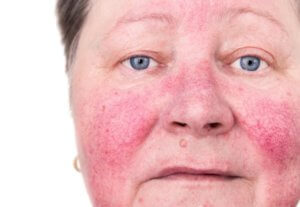
Papulopustular Rosacea
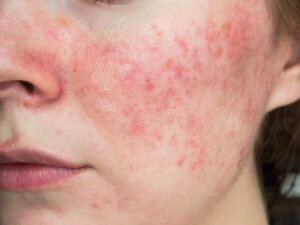
Phymatous Rosacea
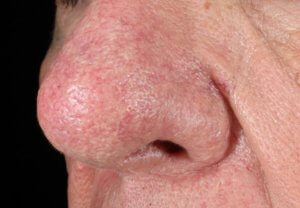
Ocular Rosacea
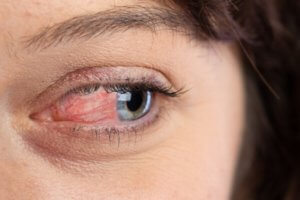
Symptoms that indicate an individual is dealing with ocular rosacea rather than other common eye conditions include:
- Visible blood vessels on the eyelids and around the eyes
- Cysts on the eyes
- Redness, itching, or swelling of the skin around the eyes
- Symptoms associated with other forms of rosacea
What are the Causes & Risk Factors Associated with Rosacea?
When it comes to an underlying cause of rosacea, there is really no specific reason people develop rosacea. Instead, people who develop this chronic skin condition seem to do so because of combined genetic predisposition and environmental exposure to specific irritants.
People at higher risk for developing rosacea include those who:
- Have fair (light) skin (especially if they also have light hair and eyes)
- Have abnormal blood vessel development and function (usually indicated by the increased visibility of blood vessels)
- Are between 30 and 50 years of age
- Are female (though men often have more severe symptoms)
- Have one or more parents or other close relatives who have the condition
- Have Helicobacter pylori (bacteria often found in the intestines)
- Have Bacillus oleronius and a related skin mite, Demodex
- Have an overabundance of cathelicidin (one of the skin’s protective proteins)
In addition to these common risk factors, patients with rosacea need to be aware of environmental factors (triggers) that can contribute to the overall ability to maintain healthy skin. Anything that makes your blood vessels dilate will increase the risk for a flareup, but every person will experience different responses to these potentially triggering factors.
Some of the common triggers include:
- Spicy foods
- Hot beverages
- Sun exposure
- Extreme temperatures or weather conditions (humidity, dryness, wind, etc.)
- Taking hot baths or showers or spending time in saunas
- Exercising or otherwise producing excessive sweat and increased body temperature
- Extreme emotional response (anger, stress, anxiety, etc.)
- Alcohol
- Some medications and treatments for chronic health conditions (including many corticosteroids and blood pressure medications)
- Acute and untreated medical conditions, especially when fever is a symptom
- Allergies (food and environmental)
- Inflammatory conditions, hormonal imbalances, and other chronic and systemic health concerns
How is Rosacea Treated?
Each type of rosacea has a unique set of symptoms and treatment options. However, no matter what type of rosacea symptoms you’re experiencing, you should be partnering with a qualified dermatologist to identify your unique triggers – the products, irritants, and conditions that cause a rosacea flareup. By identifying and avoiding the things that cause your rosacea flareups, you will be better equipped to manage symptoms that do arise.
In addition to avoiding your unique triggers for rosacea flareups, individuals with rosacea should review their skincare, cosmetics, hygiene, and cleaning products, for ingredients that can increase irritation and inflammation, including:
- Alcohol
- Camphor and menthol
- Fragrance – even naturally derived scents and essential oils
- Glycolic and lactic acids
- Sodium laurel sulfates (check your shampoo and toothpaste)
- Urea (often found in products used to treat eczema, psoriasis, and other common skin conditions)
Even if your products don’t contain any of these ingredients, they may still cause a flare-up, so it’s always recommended that patients with rosacea test a new product on a small area of rosacea-prone skin. Monitor the area (without reapplying) for a few days. If you notice any symptoms of rosacea, discontinue use.
Because the sun is a common trigger for rosacea flareups, taking time to apply sunscreen throughout the day and minimize overall exposure can go a long way toward reducing the number and longevity of symptom flareups. Don’t forget to protect your eyes by wearing sunglasses.
Erythematotelangiectatic Rosacea Treatments
When it comes to treating Erythematotelangiectatic rosacea, unfortunately, there’s not a cure for any type of rosacea, and most people will need to do some experimentation with adjusting their treatment options and skincare routines while carefully noting any situations or substances that seem to trigger a reaction. The goal is to manage the condition and avoid severe inflammation, especially since failure to manage ETR can often lead to developing the symptoms of one or more of the severe forms of rosacea.
Ongoing care plans for ETR typically include:
- A mild daily skincare routine, using fragrance-free products to clean and moisturize
- Application of prescription topical medications (brimonidine gel or oxymetazoline hydrochloride creams) to address redness
- Learning and avoiding potential triggers
- Protecting skin from the sun and limiting time outdoors, especially on very warm or sunny days
- Treating your skin gently and avoiding unnecessary irritation that can occur through the use of cleaning brushes, astringents, exfoliants, and similar products
- Using cosmetics with a green-tint to camouflage skin redness
To treat very severe cases of rosacea or during flareups, your dermatologist may recommend more advanced treatment options. If your flareup is painful or is accompanied by inflammation, itching, or irritation, laser or light therapy may be used to get the symptoms to manageable levels. Each patient with rosacea will respond differently to the use of light or laser treatments. Some will notice long term resolution of symptoms while others will only see benefits for a short time before needing retreatment. To ensure you achieve and maintain your results, you’ll want to visit the dermatologist for regular follow up visits.
Papulopustular Rosacea Treatments
Papulopustular “acne” rosacea is often treated with the same medications as other forms of acne. However, special care should be taken to avoid stripping the skin of moisture or causing unnecessary irritation, which can occur with many strong, chemical acne treatments. Instead, your dermatologist will likely prescribe oral or topical antibiotics to decrease the number of acne-causing bacteria on the skin. In addition to reducing the number of bacteria on your skin, antibiotics also have anti-inflammatory effects that are beneficial for patients with rosacea to help with swelling and redness associated with this condition.
Azelaic acid is another very effective treatment for papulopustular acne. In research, findings indicated that about 75% of patients achieved partial or complete rosacea clearance from the use of azelaic acid. In most cases, your dermatologist will instruct you to apply this topical medication twice a day (morning and evening). You may experience some tingling or burning when you first use this product, but it should diminish and go away completely over time. If the sensation gets worse or doesn’t begin to diminish within the first week of use, let your dermatologist know.
Retinoids can also be an effective topical treatment for controlled papulopustular rosacea. In most cases, the use of a vitamin A-derived retinoid treatment will be a recommended part of your maintenance skincare plan to prevent flareups of papulopustular acne. In addition to helping limit breakouts, retinoids are also great for creating an even skin tone and reducing the signs of aging, so they offer numerous benefits for the overall look and feel of your skin.
To get a severe breakout under control, especially if your papulopustular acne has been resistant to other treatments, your dermatologist may prescribe Isotretinoin. This is an effective, short-term treatment to help achieve acne clearance for severe breakouts, but due to the side effects, it’s not safe for all patients with rosacea. Before this treatment is prescribed, your dermatologist will work with you to exhaust other options.
In some cases, procedures like laser or light therapy may be recommended to help improve the appearance of redness and skin inflammation once a papulopustular rosacea flareup is under control. These treatments will help you regain healthier looking and feeling skin, especially if the deep acne papules and pustules have caused scarring or skin discoloration.
Phymatous Rosacea Treatments
Like other types of rosacea, it’s always best to diagnose and begin treating phymatous rosacea in the earliest stages of development. Without intervention, phymatous rosacea can cause serious concerns. As the thickened skin begins to buildup, it can block your eyes, ears, and nose, causing difficulties seeing, hearing, breathing, and smelling. Severe cases of bulbous nose (rhinophyma) can even make it difficult to eat or speak as the size and weight of the excess skin on the nose can limit the mobility of the mouth.
Unlike other forms of rosacea that can be cleared up over time using oral and/or topical medications, phymatous rosacea usually requires surgical treatment. Surgical intervention for phymatous rosacea typically involves slowly removing and reshaping layers of skin, using a scalpel and/or electrocautery tools. The complex procedure is usually performed by a dermatologic or plastic surgeon who is familiar with the methods of removal and who can ensure the results look good as well.
To prevent the condition from progressing, we may prescribe short term medications in combination with surgical treatment. Following the surgical removal of the excess skin, your dermatologist will work with you to create an ongoing maintenance plan to avoid a flareup in the future. Since phymatous rosacea is typically a progression of inflammation from other untreated forms of rosacea, addressing these skin conditions as outlined above will likely be an important part of your ongoing care plan.
Ocular Rosacea Treatments
Ocular rosacea is often treated with oral antibiotics.
Additionally, to address the uncomfortable symptoms of ocular rosacea, your dermatologist may recommend soothing treatments like:
- Applying warm compresses to the eye
- Using eye cleaner
- Keeping eyes moisturized with eye drops or other topical medications
Because treating conditions associated with the eye is not the main specialty area for dermatologists, we may work with eye specialists, called ophthalmologists, to ensure patients with ocular rosacea receive the best treatment and avoid more advanced concerns associated with this unique condition, including any negative impact on vision.
Finally, we’ll create a plan to help you identify your rosacea triggers and manage the symptoms associated with the skin condition to further reduce your risk for an ocular rosacea flareup. In most cases, your ongoing maintenance plan will include daily skin and eye care at home, as well as regularly scheduled follow up visits with your dermatologist.
Visit U.S. Dermatology Partners
A dermatologist is a key resource for individuals who are struggling with any form of rosacea. Whether you’ve been diagnosed in the past or you just suspect you may be suffering from rosacea, we hope you’ll reach out to a U.S. Dermatology Partners location near you to schedule a consultation with one of our knowledgeable dermatologists. We are happy to schedule a time for you to visit us in our dermatology offices, and you can start that process right now by taking a few moments to complete our simple scheduling request form. Once we receive your request, a team member will be in touch soon to verify your information and finalize all the details of your visit. We look forward to speaking with you soon.
Find a location near me
or

